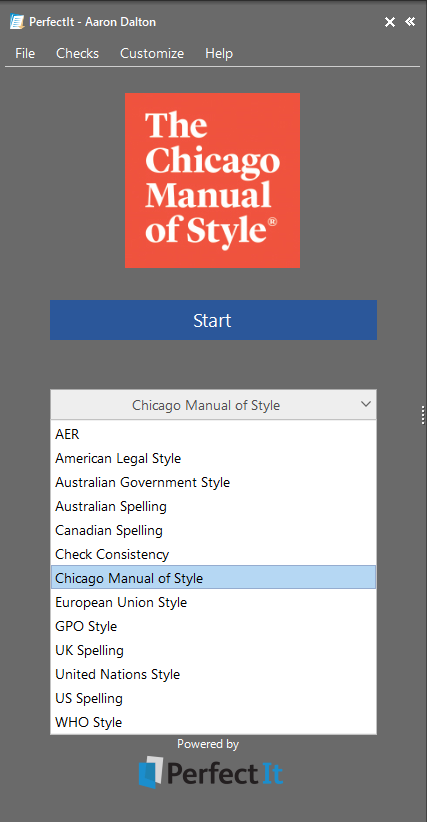Disclaimer: I received a free year of access to The Chicago Manual of Style Online (CMOS Online) and PerfectIt 5 as part of testing the beta version and writing this review.
Efficiency is key to maximizing your income. There are only so many hours in a day, so you simply must do more in those hours. Editing software can make a huge difference. Software isn’t to a point yet where it can supplant an editor. It can’t tell you that one of your side characters had blue eyes on page 30 and green on page 130. It can’t tell you that requirement 59 can be read as contradicting requirement 8. But it is very adept at doing mechanical tasks like compiling abbreviations and checking spelling. I have been using PerfectIt for years and am a big fan. Intelligent Editing recently released The Chicago Manual of Style for PerfectIt, an update I believe The Editors’ Weekly readers will want to learn about.
What is PerfectIt?
PerfectIt is at its heart a consistency checker. It examines the totality of your document and finds all the places where you did things differently. It also highlights deviations from selected preferences.
PerfectIt comes with several built-in style guides (figure 1) but also gives you complete control over its various checks. The style sheet editor (figure 2) lets you start either with something built-in or completely from scratch.
The list of things PerfectIt checks is long and fully customizable (figure 3). The ones that I personally rely on the most heavily are hyphenation, list punctuation and abbreviation checks. What initially sold me on PerfectIt was how easy it was to review and fix the inconsistencies. Figure 4 shows an example of a hyphenation check. It shows me the different versions in the document along with the counts. I can click on any particular instance and it will take me directly to it so I can see it in context. From there, I can simply click the Fix link or tweak it in the text itself.
PerfectIt will also perform finalization tasks like updating cross-references, removing excess spaces, clearing document properties and helping produce a table of abbreviations. Like any good software that works with human language, it doesn’t do anything automatically. Many inconsistencies (especially hyphenation) are not actually mistakes. But PerfectIt makes it easy to find possible issues and exercise editorial judgment.
What’s new
The most recent (fifth) version of PerfectIt has several background improvements — like the style sheet editor search feature and faster checking overall — but the most exciting new feature is its integration with The Chicago Manual of Style.
When you run a check on text, the software will not only tell you what the check found, but it will also show you specific sections of the style guide that pertain to the issue (figure 5). The CMOS style sheet, like all the others, is fully customizable (see figure 2 as an example of where you could customize hyphenation).
If you have a personal or institutional subscription to CMOS, you can link it to your PerfectIt licence. (Given the nature of this product and the collaboration between The University of Chicago Press and Intelligent Editing, they are unable to offer CMOS for PerfectIt free of charge through the Editors Canada website. Log in to the member services section of the association for more details about free and discounted access to CMOS Online and PerfectIt.)
How I use it
I brought PerfectIt into our workplace years ago and use it almost daily. It has become essential. My standard workflow is to run PerfectIt before I start my first editing pass and then again after. The first run cleans up the document so that I’m less distracted and can focus more on reviewing the content than the mechanics. Running it again after my first pass lets me reassess any decisions once I’ve read the entire text and helps catch any inconsistencies my edits may have introduced.
This workflow minimizes the number of major issues I miss because of “attentional blink.” I’m sure we’ve all experienced that moment of finding an error after the fact and wondering, How did I miss that?! Often, it’s because there was another mistake nearby, and after fixing that error, our attention “blinked” long enough for us to miss the other error right next to it. Dealing with these mechanical issues before diving into the text allows me to be more focused and effective in repairing issues software will likely never be able to detect.
I recommend PerfectIt to editors all the time. I think it’s an invaluable tool. Its design makes it easy to not only find these mechanical issues but also quickly and painlessly fix them, allowing you to make much more effective use of your billable hours. It even has a 14-day free trial.
Have you used PerfectIt or similar software in the past? Has it helped or hindered you in some way? Share your thoughts below!
___
Previous post from Aaron Dalton: What Is Plain Language? Part 2: Reading is a Skill
The Editors’ Weekly is the official blog of Editors Canada. Contact us.
Discover more from The Editors' Weekly
Subscribe to get the latest posts sent to your email.





